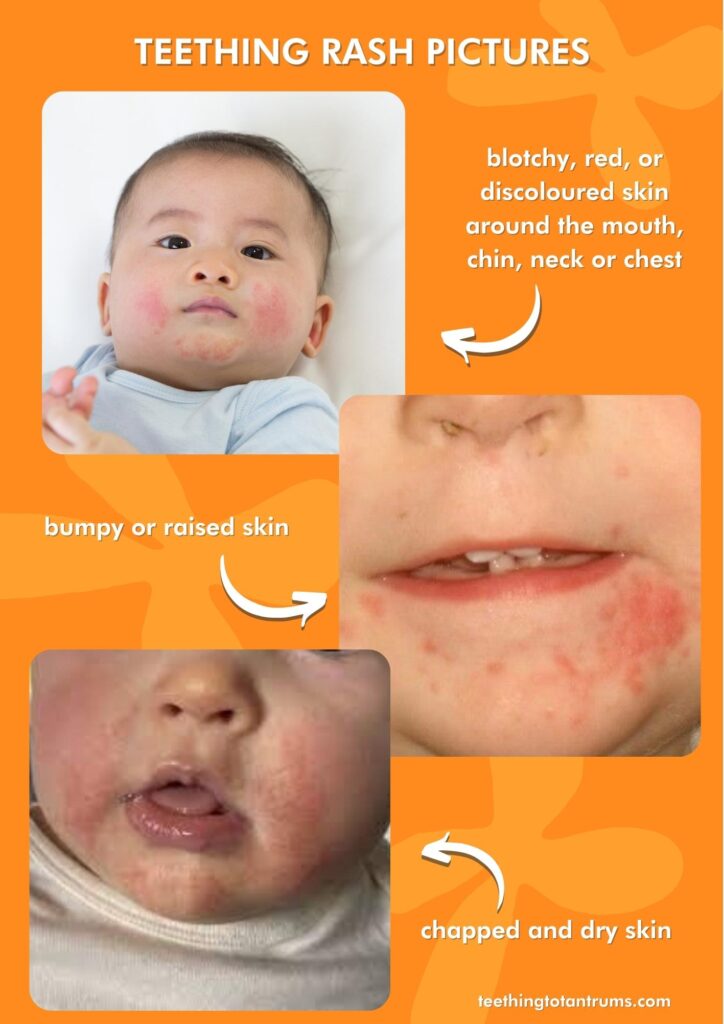Covering everything from the stages of teeth eruption, signs, toys and remedies, teething foods, teething rashes, and even baby tooth care, you will have everything you need to prepare for your little one’s teething journey.
What Is Teething?
Teething is a part of your baby’s growth and development when their milk teeth erupt through their gums. Some children sail through with very little discomfort but most will experience some uncomfortable symptoms when a tooth is emerging.
When Do Babies Start Teething?
Your baby’s first tooth will usually appear in pairs at around 6 months old, starting with the bottom two incisors followed by the top two.
This timing can vary with some babies getting their first tooth as early as 3 months and some as late as 14 months.
NOTE: By 3 years of age, all of the primary teeth should be present and correct with the permanent teeth starting to appear between the ages of 4-6 years.
- 5-7 months: bottom incisors (front)
- 6-8 months: top incisors
- 9-11 months: top lateral incisors (either side of front teeth)
- 10-12 months: bottom lateral incisors
- 12-16 months: first molars (back teeth)
- 16-20 months: canines (toward the back of the mouth)
- 20-30 months: second molars
Teething Signs
The most common symptoms you will notice when baby is teething are:
1. Drooling & Teething Rash
The most obvious sign that your baby is starting to teeth is when you notice they are drooling excessively.
You will be surprised by how much drool your baby can actually produce at this time!
To prevent a teething rash from developing on the chin or neck:
- Use something to act as a barrier to the moisture such as a baby lotion, lanolin ointment or petroleum jelly with added aloe vera. These will help stop the teething rash from spreading and reduce skin irritation.
- Gently wipe the drool off using a soft towel, cotton muslin or tissue to keep excess moisture at bay.
- Use a bib or muslin to create a protective layer that prevents your baby’s dribble from coming into contact with the skin around their neck and chest. Change these bibs regularly as damp fabrics will cause a friction rash on your baby’s chin over time.
- Minimise the use of pacifiers as they will allow an area of drool to collect between the skin and the pacifier. If you can, limit pacifier use to sleep times only. Be sure to dry the skin around your baby’s mouth after they have been using a pacifier and apply a barrier cream.
The perfect addition to every baby bag, these 100% organic muslin cotton burp cloths will be crucial on your parenting journey. Whilst being luxuriously soft and super absorbent they pose no risk of itching, irritation or annoyance to the sensitive skin of your baby.
2. Red Cheek And Ear Pulling
A teething baby may have a red or flushed cheek if they are rubbing at their face to try and distract from their discomfort.
Nerves in the ears and cheek also share the same pathways as the gums…
Therefore, pain from getting a new tooth can present itself in these areas, with your baby rubbing at their face and pulling their ears.
TOP TIP: An ear infection can also cause your baby to pull at their ears, so always check with your doctor to make sure there is nothing else amiss if they are pulling at their ears excessively.
3. Sleep Disturbances
Teething babies will often find it hard to settle and may wake more often at night.
This is usually short-lived and your baby should settle back into their normal sleep pattern once the tooth has come through.
However, to avoid sleep regression I would not recommend night feeding any more than usual in order to comfort your little one. Instead, offer comfort with a gentle tummy rub.
4. Excessive Chewing And Biting
Young babies are always putting things in their mouth anyway…
But you may notice them gnawing or biting on toys and their own fists and fingers more furiously when a tooth is about to put in an appearance.
Provide toys with lots of texture and the ability to cool down to soothe sensitive gums:
5. Swollen Gums
Swollen gums are often the most definitive way to determine if your little one has a new tooth coming or not.
By putting your finger in your baby’s mouth and passing it over the gums you should also be able to feel the emergent teeth just below the surface.
6. Irritability And Crying
The discomfort experienced when a new tooth is emerging will probably mean that your baby will be more irritable than usual and this can present itself in short bursts throughout the day, or for longer periods of time until the tooth appears.
The first teeth usually hurt the most as your little one will not have experienced this type of discomfort before.
And chances are that future teeth will not cause such a big teething tantrum…
With the exception of the molars as anyone who has experienced a wisdom tooth coming through will understand!
7. Changes To Eating Habits
Their tender gums may lead to your baby wanting to suck more on the bottle or breast due to a spoon being too uncomfortable.
For others, it may appear that they are more hungry than usual as the pressure on their gums from eating soothes the discomfort.
Either way, you are likely to see a change but try to resist the urge to return to night feeding to ease your little one’s discomfort at night.
A bedtime & nap cheat sheet so good your little one will ask you to put them to bed...
Laura Williams "This is a life saver! I'm so glad I downloaded your bedtime & nap cheat sheet. My little one actually asked me to put him to bed last night! Unbelievable! Thank you so much!"
Click Here For The FREE Cheat Sheet
Teething Remedies
Here are my favourite teething remedies that I always come back to time and time again:
- Offer cold foods or toys.
- Provide a warm cloth to soothe aching gums
- Invest in high-quality teething toys
- Give baby a gum massage
- Give baby a warm bath to help distract them
- Offering plenty of cuddles and comfort is a brilliant nonpharmacological remedy.
- Use a mesh feeder to give baby frozen foods
- Make popsicles from breastmilk, formula or fruit juice.
- Invest in a wearable teething glove for babies who are too small to coordinate a teething ring.
- Freeze a teat bottle for baby to chew on.
- Make teething biscuits.
- Offer a chilled spoon (only if baby is over 6 months old)
- Give baby a facial massage.
- Make homemade baby ice cream – mix 1 can of organic pears, 6 scoops of baby formula and 1/2 cup of organic rice blended together and frozen in an ice cube tray.
- If your baby is over 3 months old, you can give them baby-safe paracetamol or ibuprofen.
NOTE: Always follow guidance from a medical professional when administering medication to your children.
What Teething Treatments To Avoid
When baby is teething, their discomfort can be hard for us to witness. However, despite our best intentions, I would avoid the following to attempt to relieve their pain:
- Teething Gels. The use of numbing teething gel to ease the pain is really not necessary and there is a proven element of risk in doing so. The amount of relief baby teething gel can give is so minimal that it really is not worth the risk and most medical professionals will advise finding safer alternatives to relieving your baby’s emerging tooth pain.
- Teething Necklaces. I would also steer clear of teething necklaces and amber necklaces as they pose a serious choking hazard and with so many other teething toy options available, they are an unnecessary risk.
Teething Toys
For a comprehensive list of my favourite teething toys for babies of all ages and stages – check out this post.
What Food Can I Give My Teething Baby?
Teething and weaning often coincide so you may find that just when you were happily progressing with getting your little one onto solids, they start to reject certain foods or lose interest in food altogether…
So what foods are best for teething babies and what can you do to make eating more pleasurable and soothing?
Here is a list of some great foods to offer your baby:
Soft Foods
Your teething baby may prefer soft foods that don’t hurt their swollen gums such as:
- Mashed potato or sweet potato
- Minced meat (beef or chicken)
- Hummus
- Mashed banana
- Scrambled eggs
- Soft buttered toast without crusts
- Mashed avocado
- Rice cakes
- Veg and fruit purees
- Yoghurt
- Fromage frais
- Custard
- Cheese sauces
Hard Foods
Some babies prefer hard foods that they can chomp down on to relieve teething pain and discomfort.
A great option is to give baby a rusk or biscuit.
However, try to avoid store-bought ones as they can be very high in sugar.
Have a go at making your own!
There are plenty of lovely, healthy homemade teething biscuit recipes to choose from that keep well in a Tupperware for quick and convenient comfort.
One of my favourite rusk recipes is from the lovely Stacey at My Kids Lick The Bowl.
Chilled Foods
As I mentioned earlier, it is a great idea to offer your teething baby fruit and veg that have been chilled.
- Chilled watermelon
- Cold cucumber sticks
- Frozen banana
- Homemade organic fruit juice popsicles (simply freeze some organic fruit juice)
- Frozen fruit purees
- Breast milk or formula popsicles
REMEMBER: Using a mesh feeder is a great and safe way to offer chilled or frozen foods to a younger baby.
Foods To Avoid Whilst Teething
Foods that cause gum aggravation should be avoided when baby is teething. This includes:
- Salty and spicy foods.
- Acidic foods such as tomatoes and lemon juice.
- Frozen foods straight from the freezer. Frozen foods are amazing at soothing sore gums… However, they should always be taken out of the freezer for a few minutes before giving them to your baby to avoid freezer burn.
How To Care For Baby’s New Teeth
Once your baby has a tooth, use a small, soft infant toothbrush with a very small amount of infant toothpaste to clean your baby’s teeth twice a day.
However, if your baby is not keen on a toothbrush… then gently clean the tooth with a muslin cloth.
Make toothbrushing fun by singing a song, making it a game or brushing your own teeth at the same time.
REMEMBER: You will need to supervise teeth brushing until your child is 6 or 7 years old.
When Should I Take My Baby To The Dentist?
It is advisable to take your baby to the dentist for the first time when they are around 12 months old.
Taking them with you when you visit the dentist prior to this will show them that this is just a normal part of life and make them more prepared for when they go for a check-up.
NOTE: Teeth decay in young children is a growing problem so it is very important that you encourage healthy dental and eating habits from early on.
When To See A Doctor About Teething
Normally, you would not need to consult a doctor over an emerging tooth…
But if your little one has any of the following symptoms while teething then you should get them checked out by a medical professional to rule out any other underlying condition:
- They are VERY sleepy
- Baby cannot be comforted
- They have persistent diarrhoea and vomiting – accompanied by a fever
- They have a rash accompanied by a fever
- If baby is under 3 months old, and has a temp over 38°C
- If baby is over 3 months old, and has a temp of over 39°C
- Baby has a fever that lasts more than 24 hours
Frequently Asked Questions About Teething
Looking for more information about teething? Find answers to the most common questions here.
How Long Does Teething Last For?
Although it might feel like longer, on average your little one should only be out of sorts for about 8 days when teething. This is 4 days before the tooth breaks through, the day the tooth pops through and 3 days after.
Is Getting A New Tooth Painful?
Yes. Cutting teeth can be very painful as baby’s gums swell and become tender. However, the amount of pain and discomfort that each child experiences will vary greatly.
What Are The First Signs Of Teething?
The first signs of teething include swollen gums, flushed cheeks, irritability and changes in oral habits such as chewing and feeding.
Do Pacifiers Help With Teething?
Yes, pacifiers or dummies can definitely help with easing the pain from incoming front teeth. The desire to suck for comfort can be beneficial and if you put the pacifier in the fridge first that can often offer great relief. However, pacifiers can cause rashes around baby’s mouth. So use them with care.
How Can I Make My Teething Baby Happy?
The most important thing is that you offer them as much comfort as possible. Soothing a teething baby can be very hard for any parent so don’t feel guilty that you can’t stop your baby from feeling uncomfortable. Accept that your little one is in some degree of discomfort and offer them any of the solutions I have detailed in this post.
What Are The Best Ways To Soothe My Baby’s Painful Gums?
There are many ways to soothe your baby’s gums from offering cool foods, appropriate teething toys or mild pain relief. However, you may need to try a few before you find one that works for your baby.
Is My Baby Teething At 3 Months?
Yes, it is possible for your 3-month-old to be teething. The time at which a baby starts to teeth is always variable – some will start early and some will be late bloomers.
What Does Teething Rash Look Like?
Here are a few teething rash pictures to help you visualise what a rash caused by erupting teeth and excess drool can appear as:

Does Teething Trigger A Sleep Regression?
Sadly, teething and sleep regressions go hand in hand. This is because baby gets used to the extra comfort offered to help them sleep at night which stops once their tooth has emerged.
To avoid or recover from a sleep regression, you need to do the following:
- Stick to a strict nap and bedtime routine
- Provide a healthy sleep environment that is darkened, at the ideal temperature and uses a white noise machine.
- Ensure your baby has enough sleep during the day
- Watch for sleep cues and act on them quickly.
- Help your baby learn to self-settle.
- Keep nighttime interactions low key
- Avoid overstimulation before sleep time
Does Baby Teething Pain Get Worse At Night?
Baby teething pain can seem to get worse at night purely because your baby has fewer distractions than during the day.
During the day, you can keep them occupied with playing, singing, going for a walk, massaging their gums and offering them chilled teething rings or other toys to ease their discomfort…
However, babies are just like adults in that we are all more aware of pain at night time when we have less to take our mind off the discomfort it causes and we are tired.
How To Soothe A Teething Baby At Night
There is no easy way to answer how to soothe a teething baby at night. It really is a case of trying out different options.
However, try not to fall back on increasing the nighttime feeding to ease your baby’s discomfort and distress, but rather try comforting and patting to resettle your baby.
Need More Parenting Help?
- Download our FREE Bedtime & Nap Sleep Cheat Sheet. It’s a free, easy-to-use and proven formula designed for parents of 0-5 year olds to master the art of consistently undisturbed and restful sleep without the yelling, nagging or exhausting long-winded evenings.
- Check out our Parenting Toolbox. You’ll get access to expertly-chosen products that you can guarantee are the best for your little one and your wallet.
- Are you looking for personalized guidance to navigate the challenges of parenting? I offer 1-on-1 consultations to bring you tailored strategies and actionable advice to help support your child's growth and well-being with confidence.

A bedtime & nap cheat sheet so good your little one will ask you to put them to bed...
Laura Williams "This is a life saver! I'm so glad I downloaded your bedtime & nap cheat sheet. My little one actually asked me to put him to bed last night! Unbelievable! Thank you so much!"
Click Here For The FREE Cheat Sheet





